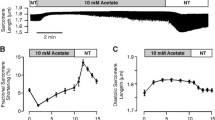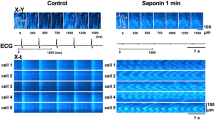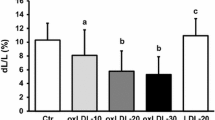Abstract
A protective effect of the n-3 polyunsaturated fatty acids (PUFAs) in preventing ventricular fibrillation in experimental animals and cultured cardiomyocytes has been demonstrated in a number of studies. In this study, a possible role for the n-3 PUFAs in the treatment of atrial fibrillation (AF) was investigated at the cellular level using atrial myocytes isolated from young adult rats as the experimental model. Electrically-stimulated, synchronously-contracting myocytes were induced to contract asynchronously by the addition of 10 μM isoproterenol. Asynchronous contractile activity was reduced following acute addition of the n-3 PUFAs docosahexaenoic acid (DHA) and eicosapentaenoic acid (EPA) at 10 μM, compared with no fatty acid addition (from 99.0 ±: 1.0% to 30.7 ± 5.2% (p < 0.05) for DHA and 23.8 ± 2.8% (p < 0.01) for EPA), while the saturated fatty acid, docosanoic acid (DA) and the methyl ester of DHA (DHA m.e.) did not exert a significant effect on asynchronous contractile activity. Asynchronous contractile activity was also reduced to 1.7 ± 1.7% in the presence of the membrane fluidising agent, benzyl alcohol (p < 0.001 vs no fatty acid addition). Cell membrane fluidity was determined by steady state fluorescence anisotropy using the fluorescent probe, TMAP-DPH. Addition of DHA, EPA or benzyl alcohol significantly increased sarcolemmal membrane fluidity (decreased anisotropy, rss) of atrial myocytes compared with no addition of fatty acid (control) (from rss = 0.203 ±0.004 to 0.159 ± 0.004 (p < 0.01) for DHA, 0.166 ± 0.001 (p < 0.01) for EPA and 0.186 ±0.003 (p < 0.05) for benzyl alcohol, while DA and DHA m.e. were without effect. It is concluded that the n-3 PUFAs exert anti-asynchronous effects in rat atrial myocytes by a mechanism which may involve changes in membrane fluidity.
Similar content being viewed by others
References
Nattel S, Hadjis T, Talajic M: The treatment of atrial fibrillation. An evaluation of drug therapy, electrical modalities and therapeutic considerations. Drugs 48: 345-371, 1994
Prystowsky EN, Benson DW, Jr., Fuster V, Hart RG, Kay GN, Myerburg RJ, Naccarelli GV, Wyse DG: Management of patients with atrial fibrillation. A Statement for Healthcare Professionals. From the Subcommittee on Electrocardiography and Electrophysiology, American Heart Association. Circulation 93: 1262-1277, 1996
Bang HO, Dyerberg J, Hjoorne N: The composition of food consumed by Greenland Eskimos. Acta Med Scand 200: 69-73, 1976
Kromhout D, Bosschieter EB, de Lezenne Coulander C: The inverse relation between fish consumption and 20-year mortality from coronary heart disease. New Engl J Med 312: 1205-1209, 1985
Burr ML, Fehily AM, Gilbert JF, Rogers S, Holliday RM, Sweetnam PM, Elwood PC, Deadman NM: Effects of changes in fat, fish, and fibre intakes on death and myocardial reinfarction: diet and reinfarction trial (DART). Lancet 334: 757-761, 1989
de Lorgeril M, Renaud S, Mamelle N, Salen P, Martin JL, Monjaud I, Guidollet J, Touboul P, Delaye J: Mediterranean alpha-linolenic acid-rich diet in secondary prevention of coronary heart disease. Lancet 343: 1454-1459, 1994
Siscovick DS, Raghunathan TE, King I, Weinmann S, Wicklund KG, Albright J, Bovbjerg V, Arbogast P, Smith H, Kushi LH, Cobb LA, Copass MK, Psaty BM, Lemaitre R, Retzlaff B, Childs M, Knopp RH: Dietary intake and cell membrane levels of longchain n-3 polyunsaturated fatty acids and the risk of primary cardiac arrest. JAMA 274: 1363-1367, 1995
McLennan PL, Abeywardena MY, Charnock JS: Dietary fish oil prevents ventricular fibrillation following coronary artery occlusion and reperfusion. Am Heart J 116: 709-717, 1988
McLennan PL, Bridle TM, Abeywardena MY, Charnock JS: Dietary lipid modulation of ventricular fibrillation threshold in the marmoset monkey. Am Heart J 123: 1555-1561, 1992
McLennan PL, Bridle TM, Abeywardena MY, Charnock JS: Comparative efficacy of n-3 and n-6 polyunsaturated fatty acids in modulating ventricular fibrillation threshold in marmoset monkeys. Am J Clin Nutr 58: 666-669, 1993
Kang JX, Leaf A: Effects of long-chain polyunsaturated fatty acids on the contraction of neonatal rat cardiac myocytes. Proc Natl Acad Sci USA 91: 9886-9890, 1994
Kang JX, Leaf A: Prevention and termination of beta-adrenergic agonist-induced arrhythmias by free polyunsaturated fatty acids in neonatal rat cardiac myocytes. Biochem Biophys Res Commun 208: 629-636, 1995
Kang JX, Leaf A: Evidence that free polyunsaturated fatty acids modify Na+ channels by directly binding to the channel proteins. Proc Natl Acad Sci USA 93: 3542-3546, 1996
Xiao YF, Kang JX, Morgan JP, Leaf A: Blocking effects of polyunsaturated fatty acids on Na+ channels of neonatal rat ventricular myocytes. Proc Natl Acad Sci USA 92: 11000-11004, 1995
Leifert WR, McMurchie EJ, Saint DA: Inhibition of cardiac sodium currents in adult rat myocytes by n-3 polyunsaturated fatty acids. J Physiol 520. 3: 671-679, 1999
Hallaq H, Smith TW, Leaf A: Modulation of dihydropyridinesensitive calcium channels in heart cells by fish oil fatty acids. Proc Natl Acad Sci USA 89: 1760-1764, 1992
Kang JX, Xiao YF, Leaf A: Free, long-chain, polyunsaturated fatty acids reduce membrane electrical excitability in neonatal rat cardiac myocytes. Proc Natl Acad Sci USA 92: 3997-4001, 1995
McMurchie EJ, Leifert WR, Head RJ: Antiarrhythmic Properties of n-3 Fatty Acids in Cardiomyocytes: A Role for Membrane Fluidity? In: R.A. Riemersma, R.A. Armstrong, R.W. Kelly, R. Wilson (eds). Essential Fatty Acids and Eicosanoids. AOCS Press, Champaign, IL, 1998, 6, pp 284-289
Leifert WR, Jahangiri A, McMurchie EJ: Antiarrhythmic fatty acids and antioxidants in animal and cell studies (Review). J Nutr Biochem 10: 252-267, 1999
Leifert WR, Jahangiri A, McMurchie EJ: Membrane fluidity changes are associated with the antiarrhythmic effects of docosahexaenoic acid in adult rat cardiomyocytes. J Nutr Biochem 11: 38-44, 2000
Lentz BR: Membrane “fluidity” as detected by diphenylhexatriene probes. Chem Phys Lipids 50: 171-190, 1989
Sinicrope FA, Dudeja PK, Bissonnette BM, Safa AR, Brasitus TA: Modulation of P-glycoprotein-mediated drug transport by alterations in lipid fluidity of rat liver canalicular membrane vesicles. J Biol Chem 267: 24995-25002, 1992
Coumel P: Autonomic influences in atrial tachyarrhythmias. J Cardiovasc Electrophysiol 7: 999-1007, 1996
Katz AM: Ionic and pharmacological actions on cardiac rate and rhythm. In: P.J. Goodhart, H.L. Goodhart (eds). Physiology of the Heart. Raven Press, New York, 1977, 14, pp 229-256
Priori SG, Corr PB: Mechanisms underlying early and delayed afterdepolarizations induced by catecholamines. Am J Physiol 258: H1796-1805, 1990
Kang JX, Leaf A: Protective effects of free polyunsaturated fatty acids on arrhythmias induced by lysophosphatidylcholine or palmitoylcarnitine in neonatal rat cardiac myocytes. Eur J Pharmacol 297: 97-106, 1996
Hock CE, Beck LD, Bodine RC, Reibel DK: Influence of dietary n-3 fatty acids on myocardial ischemia and reperfusion. Am J Physiol 259: H1518-1526, 1990
Nair SS, Leitch JW, Falconer J, Garg ML: Prevention of cardiac arrhythmia by dietary (n-3) polyunsaturated fatty acids and their mechanism of action. J Nutr 127: 383-393, 1997
Weylandt KH, Kang JX, Leaf A: Polyunsaturated fatty acids exert antiarrhythmic actions as free acids rather than in phospholipids. Lipids 31: 977-982, 1996
McMurchie EJ: Dietary Lipids and the Regulation of Membrane Fluidity and Function. In: R.C. Aloia, C.C. Curtain, L.M. Gordon (eds). Physiological Regulation of Membrane Fluidity. Alan R. Liss Inc. New York, 1988, 7, pp 189-237
Nazir SA, Lab MJ: Mechanoelectric feedback and atrial arrhythmias. Cardiovasc Res 32: 52-61, 1996
Leaf A, Weber PC: Cardiovascular effects of n-3 fatty acids. New Engl J Med 318: 549-557, 1988
Author information
Authors and Affiliations
Rights and permissions
About this article
Cite this article
Jahangiri, A., Leifert, W., Patten, G. et al. Termination of asynchronous contractile activity in rat atrial myocytes by n-3 polyunsaturated fatty acids. Mol Cell Biochem 206, 33–41 (2000). https://doi.org/10.1023/A:1007025007403
Issue Date:
DOI: https://doi.org/10.1023/A:1007025007403




